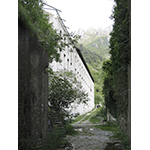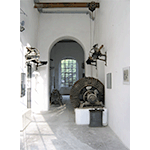Filanda di Forno - Ex Cotonificio Ligure [Forno Spinning Mill - Former Ligurian Cotton Mill]
The forthcoming opening of a massive factory was announced in 1889, which was to be sited in the vicinity of the source of the Frigido River in the locality of Forno. The factory was destined to the manufacture of cotton, exploiting the abundant and continuous supply of water necessary for the various processing phases. A few years earlier, in 1881, the cotton mill owners had obtained a license to dig a drainage canal (approximately 550 metres long) for the turbine in order to obtain water from the spring. The turbine was positioned at the bottom of a well so as to utilise the greater power of the water which, at that point, made a leap of some 64 metres. In 1893, the Societą del Cotonificio Italiano al Forno had three steam boilers, a 500 horsepower engine, and a 750 horsepower hydraulic motor.
Built on a project by engineer Frimi, the factory consisted of the cotton mill buildings and a warehouse, a building for the offices, the workshop and the director’s residence, and a housing complex for the workers. With load-bearing walls and floors made of iron and brick, the cotton mill was divided by cast-iron columns, a subdivision which was also visible from outside, as the side bodies were taller. The different architectural definition of the various floors also identified their different destination of use: the cotton was washed and beaten in the basement; the English-made Brother looms were on the first and second floors; the equipment for special processes were lodged on the top floor. Cotton manufacture followed a process divided into six phases (wetting, beating, ironing, carding, intermediate benches and spinning).
Hit by the economic and industrial crisis of the late 1930s and penalised by the closing of the steam tramway, the cotton mill gradually decreased production until it ceased at the beginning of World War II. Transformed into a warehouse by the Navy, the complex was despoiled and damaged by the German army. A recent restoration project is intended to recover the complex, particularly the spinning building and the machinery and water mains still preserved today.
****************************
Texts by Graziano Magrini
English translation by Victor Beard
Last update 16/gen/2008





